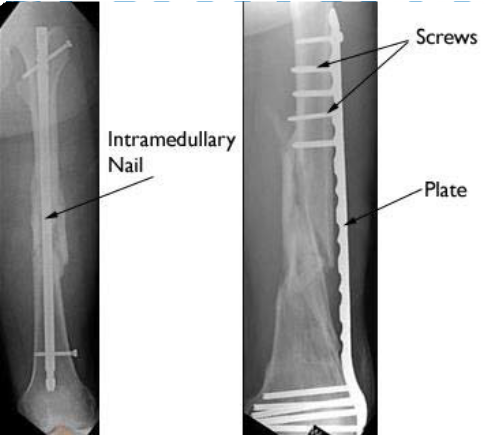A broken bone must be carefully stabilized and supported until it is strong enough to handle the body's weight and movement. Until the last century, providers relied on casts and splints to support and stabilize the bone from outside the body. Today, advances in research and surgery allow providers to internally set and stabilize fractured bones.
During a surgical procedure to set a fracture, the bone fragments are first repositioned (reduced) into their normal alignment. They are held together with special implants, such as plates, screws, nails, and wires.
Internal fixation allows shorter hospital stays, enables patients to return to normal activities earlier, and reduces the incidence of nonunion and malunion (healing in improper position) of broken bones.
The implants used for internal fixation are made from stainless steel and titanium, which are durable and strong. If a joint needs to be replaced, rather than fixed, these implants may be made of cobalt and chrome. Implants are compatible with the body and rarely cause an allergic reaction.
How to plates help treat broken bones?
Plates are like internal splints that hold the broken pieces of bone together. They are attached to the bone with screws. Plates may be left in place after healing is complete, or they may be removed (in select cases).
How do screws help treat broken bones?
Screws are used for internal fixation more often than any other type of implant. Although the screw is a simple device, there are different designs based on the type of fracture and how the screw will be used. Screws come in different sizes for use with bones of different sizes. Screws can be used alone to hold a fracture, as well as with plates, rods, or nails. After the bone heals, screws may be either left in place or removed.
How do screws and rods help treat broken bones?

(Left) This x-ray shows a healed thighbone fracture treated with intramedullary nailing. (Right) In this x-ray, the thighbone fracture has been treated with plates and screws.
In some fractures of the long bones the best way to hold the bone pieces together is by inserting a rod or nail through the hollow center of the bone that normally contains some marrow. Screws at each end of the rod are used to keep the fracture from shortening or rotating, and also hold the rod in place until the fracture has healed. Rods and screws may be left in the bone after healing is complete. This is the method used to treat the majority of fractures in the femur (thighbone) and tibia (shinbone).
How do wires and pins help treat broken bones?
Wires are often used to pin the bones back together. They are often used to hold together pieces of bone that are too small to be fixed with screws. In many cases, they are used in conjunction with other forms of internal fixation, but they can be used alone to treat fractures of small bones, such as those found in the hand or foot. Wires are usually removed after a certain amount of time, but may be left in permanently for some fractures.
Departments and Programs Who Treat This Condition
Fracture Surgery
Orthopedic Surgery
Fracture Care
 en
en 
 Français
Français Deutsch
Deutsch Italiano
Italiano Español
Español Tiếng Việt
Tiếng Việt Kreyol ayisyen
Kreyol ayisyen